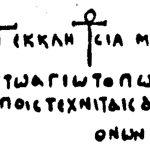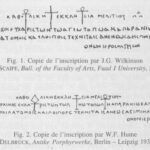| Artefact ID | 1231 |
| TM ID | TM 81596 |
| Findspot (DEChriM ID) | 65 (Ǧabal Abū Duḫān) | Class | Textual |
| Material | Stone |
| Writing medium | Inscription |
| Text content | Subliterary |
| Language | Greek |
| Description | I.Pan du désert 28; SB V 8162; SEG XLIX 1488 [28] descr. Stone slab (granite?) found on the road leading from the temple of Sarapis to the quarries on the mountain known as Lykabettos, near a small granite column, which may have served as a support for the slab. The inscription, after Wilkinsonʼs copy (1826) and Łajtar and Wipszycka 1994, reads: “Katholike church of Melitios Π''Π – I, Didymos of the officium of the eparchy, thankful for this sacred place, restored it, together with Paranios and Panachates, chief quarrymen, and the other craftsmen, during the work of bringing down the columns destined for Jerusalem.” In the titulus, the words καθολική and εκκλησία are separated from each other by a large (simple) cross, and within each of them is a crux ansata. Some elements of interpretation suggested by Łajtar and Wipszycka 1994: - Melitios mentioned in the heading of the inscription can be no one else than the famous heretic from Lykopolis who divided the Egyptian church shortly after Diocletian’s persecutions; he was condemned to work in the quarries of Mons Porphyrites. - The Melitians used the epithet katholike to underline that their community rather than that of the Athanasians of the nearby church of Biʾr Naqāṭ (I.Pan du désert 27) represented the sole true Church. - Π''Π interpreted as nomen sacrum for Yahve – rather than an abbreviation π(ραι)π(οσίτου) (I.Pan, following D. Meredith) or π(ά)π(α) (J. Dummer) - This “sacred place” (τῷ ἁγίῳ τόπῳ) would be the church itself that was restored by Didymos. |
| Selection criteria | Mention of Christian cult officials/institutions, Christian symbols/gestures/isopsephy, Nomina sacra |
| Date from | 300 |
| Date to | 399 |
| Dating criteria | Dated to 4th c. by Bernand 1977. Łajtar and Wipszycka 1994 note that the mention of the chalasis of the columns intended for Jerusalem is the only element allowing for a more refined date: R. Delbrück suggested to see there an allusion to the works undertaken by Constantine c. 335 – a hypothesis that is possible, but unprovable. In any case, the church was in activity at the same period as the church of Biʾr Naqāṭ (I.Pan du désert 27), located not far away. According to Bernand, this inscription might also be contemporary with I.Pan du désert 29. |
| Absolute/relative date | Relative date |
| Archaeological context | John G. Wilkinson found the stone at Ǧabal Abū Duḫān, on the steep ramp or causeway leading up to the high Lykabettus village and quarries. |
| Accession number | The inscription was first copied by John G. Wilkinson in 1826, and later, in 1898, by W.F. Hume, but it disappeared at some point between 1898 and 1932. |
ARTEFACT IDENTIFIERS
Reference edition
• Łajtar, Adam and Wipszycka, Ewa. 1994. “Deux ΚΑΘΟΛΙΚΑΙ ΕΚΚΛΗΣΙΑΙ dans le Mons Prophyrites.” Journal of Juristic Papyrology 24, 71-85 (dr. of 28; texts; translations).
Previous publications
• Bernand, André. 1977. Pan du désert. Leiden, no. 28.
• Meredith, David. 1953. “Eastern Desert of Egypt: Notes on Inscriptions.” Chronique d'Égypte 28, 126-141, no. 4 (p. 131-133 ).
• Delbrück, R. 1932. Antike Porpyrwerke. Berlin-Leipzig, p. xxiv.
• Scaife, C.H.O. 1935. "Two inscriptions at Mons Porphyrites (Gebel Dokhan), also a description with plans, of the stations between Kainopolis and Myos Hormos together with some of the ruins in the neighbourhood of Gebel Dokhan." Bulletin of the Faculty of Arts, Fuad I University III.2, 58-104 (esp. 58-61).
• Wilkinson, J. 1832. “Notes on a Part of the Eastern Desert of Upper Egypt.” Journal of the Royal Geographical Society of London 2: 49.
Additional bibliography
• Barron T. and Hume, W.F. 1902. Topography and Geology of the Eastern Desert of Egypt, Cairo: National printing Dept., 27-28.
• Bingen, Jean. 1996. “Bulletin épigraphique. Égypte et Nubie.” Revue des études grecques 109/2: 659-660 (no. 534).
• Fraser, Peter Marshall. 1954. Journal of Egyptian Archaeology 40, p. 128 no. 20 (4).
• Ghica, Victor. 2016. “Vecteurs de la christianisation de l’Égypte au IVe siècle à la lumière de l’archéologie.” In Acta XVI congressus internationalis archaeologiae christianae Romae (22-28.9.2013). Costantino e i Costantinidi: l’innovazione costantiniana, le sue radici e i suoi sviluppi, Studi di antichità cristiana 66, edited by O. Brandt, G. Castiglia and V. Fiocchi Nicolai, Vol. I, Città del Vaticano: Pontificio Istituto di Archeologia Cristiana, 244-245.
• Van Rengen, Wilfried. 2007. Mons Porphyrites 1994-1998. II. Excavations, edited by V. Maxfield and D. Peacock, London: Egypt Exploration Society, 403-404 (no. 1.9).
• Pleket, H.W., Stroud, R.S. and Strubbe, J.H.M. 1994. “SEG 44-1488. Mons Porphyrites. Building inscriptions concerning καθολικαὶ ἐκκλησίαι, 325-339 / 4th cent. A.D.” In Supplementum Epigraphicum Graecum, Current editors: A. T. E. N. Chaniotis Corsten Stavrianopolou Papazarkadas. Consulted online on 23 June 2021.


 Json data
Json data





